A Clinical Study of the Efficacy of Varadi Kashaya Vati and Navak Guggulu in the Management of Sthaulya w.s.r. to Childhood Obesity
Usha Damor1,P P Vyas2and Harish Kumar Singhal3*
1P.G. Scholar, Department of Kaumarbhritya, University College of Ayurved, India
2Associate Professor & Head, Department of Kaumarbhritya, University College of Ayurved, India
3Associate Professor, Department of Kaumarbhritya, University College of Ayurved, India
Submission:February 26, 2022; Published: March 22, 2022
*Corresponding author: Harish Kumar Singhal, Associate Professor, Department of Kaumarbhritya, University College of Ayurved, Dr. S. R. Rajasthan Ayurved University, Jodhpur, Rajasthan, India
How to cite this article: Usha D, P P Vyas, Harish K S. A Clinical Study of the Efficacy of Varadi Kashaya Vati and Navak Guggulu in the Management of Sthaulya w.s.r. to Childhood Obesity. Ortho & Rheum Open Access J. 2022; 19(5): 556025. DOI: 10.19080/OROAJ.2022.19.556025
Abstract
Obesity is a condition in which excess body fat has been accumulated in different parts in the body mainly in the subcutaneous tissues. It has an adverse effect on health and leads to reduced life expectancy as well as increased health problems. The World Health Organization has identified obesity as a global epidemic. The term “Sthaulya” is described in Ayurveda for “Overweight and Obesity”. This study was undertaken to identify the efficacy of Varadi Kashaya and Navak Guggulu which are mentioned in Sahasram Yoga and Yogaratnakar respectively, in the treatment of Medoroga. Total 40 children of either sex of age group 10-16 years were randomly selected from OPD & IPD of-Hospital of University College of Ayurved, Karwar, Jodhpur and Kanniram Salagram Satellite Ayurved Hospital, Magara Punjala, Jodhpur and randomly divided into two groups viz Group A & Group B. Group A children were treated with Varadi Kashaya Vati while Navak Guggulu was given to Group B children in dose of 10mg/body weight/day twice a day for a period of two months. Navak Guggulu was found to have significant effect in reducing the symptoms of medo dushti and in reduction of objective parameters like Bodyweight, B.M.I., Skinfold thickness, Body circumference and lipid profile. However, both medicine Navak Guggulu and Varadi Kashaya Vati were found effective in the management of childhood obesity, but Navak Guggulu was found superior over Varadi Kashaya Vati.
Keywords: Sthaulya; Varadi Kashaya; Navak guggulu; Obesity
Introduction
Health is a relationship between mind, soul and body, but now a days the synchronization between mind and body is disturbed which results in lots of physical, mental and psychological issues. Obesity is one of the burning health issues of today’s time, even children are not exempt from this. Obesity (Sthaulya) is frowned upon by society for both social and medical reasons. Sthaulya is Santarpanjanya Vikar [1] means "overnutrition." Sthaulya is classified as Medoroga in Ayurveda. When Agni, or digestive power, is disrupted, Ama is produced, which disrupts tissue fire in fatty tissues and prevents the normal development of new tissues. Obesity is caused by the accumulation of improperly produced fatty tissue in the body. Due to the Chala Guna of Vata, accumulated fats disrupt Vata's mobility, which in turn promotes hunger. Children, as a result, it's more of a whole meal is then converted into improper fatty tissue [2]. In Kashyapa Samhita, Sthaulya is considered as one among the Ashtanindita Purusha while explaining the anthropology. Both these persons- the obese and the emaciated- are to be deprecated always' that of medium physique is best; among the obese and the emaciated, the emaciated is better [3]. Childhood obesity is one of the most important nutritional health crisis at national and international level. The problem is global and is affecting many low- and middle-income countries, particularly in urban areas.
The prevalence has increased at an alarming rate. Globally in 2010, the number of overweight children under the age of five is estimated to be over 42 million. Close to 35 million of these are living in developing countries [4]. Obesity has spread rapidly over the world. The middle and upper classes are the worst affected. Body fat makes a person sluggish, decreases his was power, and lowers his immunity. Children become overweight and obese for different causes. The most common causes are genetic factor, lack of physical activities, sedentary life style, excessive sleep,sleeping during day especially soon after meal and unhealthy food habits like junk foods, street food etc. Obesity and overweight are caused by a discrepancy in the number of calories consumed and used. Childhood obesity is one of the most serious public health challenges of the 21st century. The problem is global and steadily affecting many low- and middle-income countries, particularly in urban settings.
Need of Study
Sahasram Yoga [5] and Yogaratnakar [6] emphasize the uses of the Varadi Kashaya Vati and Navak Guggulu which is claimed effective for the Sthaulya. In the present study, Varadi Kashaya Vati and Navak Guggulu are taken for Clinical trial which are quoted from Sahasram Yogakashya prakarana 63/10 and Yogaratnakar Medoroga chikitasa-1. It mainly contains drugs like Sunthi, Maricha, Pippali, Chitraka, Haritaki, Bibhitaki, Amalaki, Musta, Vidanga, Guggulu, Nisha, Asana. Almost all the Drugs are having Katu Rasa, Laghu Ruksha Guna, Ushna Virya, Katu Vipaka and Kapha Vata Shamaka properties which may be helpful in disintegrating the Samprapti of Sthaulya. These showed encouraging results in reduction of weight, skin fold thickness, body circumference and associated signs and symptoms.
Aims & Objectives
• To evaluate the efficacy of Varadi Kashaya Vati in the management of childhood obesity.
• To evaluate the efficacy of Navak Guggulu in management of childhood obesity.
• To compare the efficacy of Varadi Kashaya Vati and Navak Guggulu in the management of childhood obesity.
• To collected literature on Sthaulya W.S.R. to obesity from Ayurveda and modern.
Clinical study Source of Data
Total 40 children of either sex of age group 10-16 years were randomly selected from OPD & IPD of-
i. Hospital of University College of Ayurved, Karwar, Jodhpur
ii. Kanniram Salagram Satellite Ayurved Hospital, Magara Punjala, Jodhpur
Selection of children
A. Inclusion criteria
• Children age group from 10-16 years of either sex were selected for study.
• Children having cardinal feature of childhood obesity were selected.
• Children having BMI 86th percentile – 94th percentile and above 95th percentile were included in this present study.
B. Exclusion criteria
• Children age below 0-9years & above 16 years of age were excluded from the study.
• Children receiving drugs like steroids and antidepressants etc were excluded from the study.
• Childhood obesity due to any endocrinal disorders like Cushing syndrome, hypothyroidism etc were excluded.
• Children having BMI below 5th percentile were not considered.
C. Discontinuation Criteria
• Parents of children not willing to continue.
• During the course of clinical trial, if a child develops any serious condition which requires urgent treatment.
• A child her/his self wants to withdraw from the clinical trial.
D. Protocol of Research
• Consent of children after making her aware of merits/demerits of trial with duration of the proposed trial.
• Fulfilment of inclusion criteria.
• Registration of obese children.
• Investigations mentioned were advised to her/him before presenting Ayurvedic formulation (Tables 1-3).
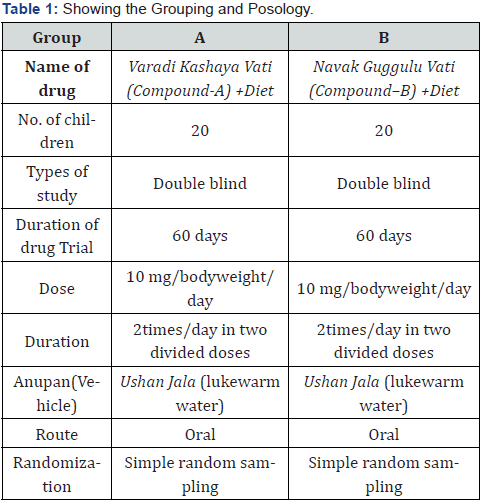

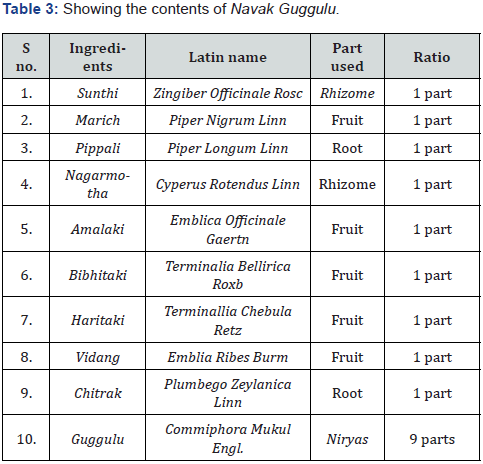
Both trial drugs were prepared as per guidelines given in Sahasram Yoga and Yogaratnakar in pharmacy of University College of Ayurveda, Dr. S.R. Rajasthan Ayurveda University Jodhpur. Both drugs were of similar physical character like color, flavor, taste and packed in similar packing to avoid biassing. Coding of study drugs was be done by another person not related to this study. Coded document was kept under safety and opened after the completion of study to decode the compounds. The selected children were subjected to careful history taking by using specially prepared research questionnaire and assessed by subjective and objective parameters before and after treatment.
Statistical Analysis
All the results were calculated by using Software: PSS 17.0
Intra Group Comparison –For Nonparametric Data Wilcoxon Matched pairs signed ranks test was used while for Parametric Data Paired ‘t’ Test was used and results were calculated.
Inter Group Comparison- For Nonparametric variables Mann Whitney U test was used while for Parametric Data unpaired t-test was used. The results were calculated (Table 4).

Observations
Total 40 children were registered in this trial study. Among them 20 children had been included in Group A and other 20 children were registered in Group B.
Age -Maximum 55% of children in both group A and group B were in 14-16 years age, 22.5 % no. of children belongs to age group 10-12 years in both groups. It means that youngsters in their adolescent years are more likely to become obese. It is Madhyama Kala, according to Ayurveda, and it leads to " Paripurnata" in all Sharir Dhatus. Obesity is more common in adolescents, according to recent sources.
Sex-Male predominance was evident in both group (group A -55% children were male, and 45 % children were female.)
Religion-Majority of the population i.e.,87.5% children were Hindu in both groups. followed by Muslim community12.5 %. This may be the representation of the total community distribution in Jodhpur city and surrounding from where most of the children came.
Socio Economic Status- Maximum 80% children were from upper middle status and 20% children were from lower middle status.
Habitat- 70 % children were from Urban area in both groups while 30 % children belong to rural habitat. Overnutrition is more likely in children who have easy access to their necessities and live-in calm, non-violent environments.
Dietary Habits-Mixed dietary were found to be more i.e., 75% individuals and individuals of children have vegetarians’ diet was 25%.
Dosha - 40% of children had Pitta Kapha and 5% of children had Vata Kapha which shows Kapha predominancy in Sthaulya.
Satva- Satva was of Pravara type in 45.00% and 30% of children in group A and group B respectively, while it was Madhyama type in 55% and 70% and none of children found in Avara type Satva in groups respectively.
Ahara Shakti- 5 % children had Madhyam Ahara Shakti and 57.5% children had Pravara Ahara Shakti.
Jarana Shakti - 5% children had Avara Jarana Shakti, 42.5 % children had Madhyam Jarana Shakti and 55 % children had Pravara Jarana Shakti. Vyayam Shakti - 5% children had Alpa Vyayam, 12.5% children had Heena Vyayam and 60% children had Madhyam Vyayam. It shows how etiological factors, such as Avyayam, have a role in the occurrence of Sthaulya. Obesity is mostly caused by a lack of physical activity. This assertion is validated by both ancient and modern medical knowledge.
Desha-5% children had Aanoop Dehsha and 87.5% children had Jangal Desha.
Agni-5% children had Sama Agni and 12.5 children had Vishama Agni. Medo Roga children had an increased Jatharagni, which leads to increased food consumption. Also, according to Acharya Charaka, the Avaran of Vayu causes excessive hunger in Agni's Medo Roga Sandhukshana, generating a desire to eat more frequently. It is also characterised by rapid food digestion, which perpetuates the cycle of increased hunger. Vishamagni and Tikshnagni in children could be caused by Koshthastha Vayu and Sandhukshita Agni
Kostha-5% children had Madhyam Kostha, 20% children had Krura Kostha and 12.5 % children had Mridu Kostha. Most of the children had Madhyama Koshtha, which is a Kapha dominancy Koshtha that forms the foundation for Obesity. Madhyama Kostha is mostly caused by Kapha dominance, according to Ashtanga Hridaya.
Nidra- 15 % children had Atinidra and 85 % children had Samyak Nidra. Excess sleep is one of the main reasons of obesity, as it produces Kapha Prakopa and increases the Meda Dhatu, therefore acting as an etiological factor. Divaswapana also causes vitiation in all three Doshas and an excessive rise in the Meda Dhatu due to the Snigdha-Abhishyandi property's blockage. Divaswapana is strongly prohibited in Medasvi, Kapha Prakriti, and Kapha Rogi Both of the aforesaid variables create Meda Vriddhi, which leads to the creation of Shithila Medo Dhatu, which aids in the pathogenesis of obesity.
Addiction-40% children had addiction of tea, 7.5% children had addiction of Coffee and 52.5 % children had no addiction.
Duration-10% children had 2-year duration of disease, 45% children had 3-year duration of disease, 35 % children had 4-year duration of disease and 10 % children had 5-year duration of disease. World health organization has listed obesity in diet related chronic disease.
Results
Effect of Therapy on Atipipasa/ Excessive Thirst
P-Value for Group A was less than 0.001 and Group B was less than 0.001. Effect observed in Group A was extremely significant and Group B was extremely significant. Thus, the effect observed in Group A was 50% and Group B was 63.89%.
Effect of Therapy on Anga Gaurav
P-Value for Group A was less than 0.001 and Group B was less than 0.001. Effect observed in Group A was extremely significant and Group B was extremely significant. Thus, the effect observed in Group A was 51.85% and Group B was 54.55%.
Effect of Therapy on Alasya/Javoparodha
P-Value for Group A was less than 0.001 and Group B was less than 0.001. Effect observed in Group A was extremely significant and Group B was extremely significant. Thus, the effect observed in Group A was 54.55% and Group B was 61.11%.
Effect of Therapy on Atikshudha
P-Value for Group A was less than 0.001 and Group B was less than 0.001. Effect observed in Group A was extremely significant and Group B was extremely significant. Thus, the effect observed in Group A was 45.16% and Group B was 63.16%.
Effect of Therapy on Nidradhikya
P-Value for Group A was less than 0.001 and Group B was less than 0.001. Effect observed in Group A was extremely significant and Group B was extremely significant. Thus, the effect observed in Group A was 48% and Group B was 51.35%.
Effect of Therapy on Daurgandhya
P-Value for Group A was less than 0.01 and Group B was less than 0.001. Effect observed in Group A was very significant and Group B was extremely significant. Thus, the effect observed in Group A was 50% and Group B was 69.57%.
Effect of Therapy on Kshudra Shwasa
P-Value for Group A was less than 0.01 and Group B was less than 0.001. Effect observed in Group A was very significant and Group B was extremely significant. Thus, the effect observed in Group A was 52.63% and Group B was 62.96%.
Effect of Therapy on Swedadhikya
P-Value for Group A was less than 0.01 and Group B was less than 0.001. Effect observed in Group A was very significant and Group B was extremely significant. Thus, the effect observed in Group A was 46.67% and Group B was 55.56%. Thus, it may be concluded that mostly combination of Katu- Rasa, Laghu, Ruksha and Ushna-Virya, Katu-Vipaka Pradhana drugs in Navak Guggulu having all the properties can do the function of Stroto Vibandhanashana and against Kapha, Kleda and Meda. These drugs may be effective on Rasa, Meda, Medodhatvagni, which provided good results in all signs and symptoms.
Comparison between Group A and Group B
For comparison between Group A and Group B Mann Whitney U Test was used. From above table it was observed that, there was significant difference observed in Group A and Group B for Atipipasa, Atikshudha, Nidradhikya, Daurgandhya, Kshudra Shwasa, Swedadhikya.
Effect of Therapy on Serum Cholesterol
P-Value for Group A was less than 0.001 and Group B less than 0.001. Effect was observed in Group A was extremely significant and Group B was extremely significant. Thus, the effect observed in Group A was 7.66% and Group B was 8.88%
Effect of Therapy on Serum Triglyceride
P-Value for Group A was less than 0.001 and Group B was less than 0.001. Effect was observed in Group A was extremely significant and Group B was extremely significant. Thus, the effect observed in Group A was 4.41% and Group B was 5.68%.
Effect of Therapy on HDL
P-Value for Group A was less than 0.05 and Group B was less than 0.01. Effect observed in Group A was significant and Group B was very significant. Thus, the effect observed in Group A was 1.91% and Group B was 3.28%.
Effect of Therapy on VLDL
P-Value for Group A was greater than 0.05 and Group B was less than 0.001. Effect observed in Group A was not significant and Group B was extremely significant. Thus, the effect observed in Group A was 0.61% and Group B was 3.22%.
Effect of Therapy on LDL
P-Value for Group A was less than 0.01 and Group B was less than 0.001. Effect observed in Group A was very significant and Group B was extremely significant. Thus, the effect observed in Group A was 1.47% and Group B was 2.62%.
Comparison between Group A and Group B
For comparison between Group A and Group B, unpaired t-test was used. From above table it was observed that, there was significant difference observed in Group A and Group B for Serum Cholesterol, Serum Triglyceride, VLDL and LDL and there was no significant difference observed in Group A and Group B for HDL.
Effect of Therapy on Weight
P-Value for Group A was less than 0.001 and Group B was less than 0.001. Effect observed in Group A was extremely significant and Group B was extremely significant. Thus, the effect observed in Group A was 5.49% and Group B was 5.87%.
Effect of Therapy on BMI
P-Value for Group A was less than 0.001 and Group B was less than 0.001. Effect observed in Group A was extremely significant and Group B was extremely significant. Thus, the effect observed in Group A was 3.97% and Group B was 5.96%.
Effect of Therapy on MAC
P-Value for Group A was less than 0.001 and Group B was less than 0.001. Effect observed in Group A was extremely significant and Group B was extremely significant. Thus, the effect observed in Group A was 2.04% and Group B was 3.04%.
Effect of Therapy on Waist Circumference
P-Value for Group A was less than 0.001 and Group B was less than 0.001. Effect observed in Group A was extremely significant and Group B was extremely significant. Thus, the effect observed in Group A was 2.49% and Group B was 3.50%.
Effect of Therapy on Hip Circumference
P-Value for Group A was less than 0.001 and Group B was less than 0.001. Effect observed in Group A was extremely significant and Group B was extremely significant. Thus, the effect observed in Group A was 1.97% and Group B was 3.46%.
Effect of Therapy on WHR
P-Value for Group A was greater than 0.05 and Group B was greater than 0.05. Effect observed in Group A was not significant and Group B was not significant. Thus, the effect observed in Group A was 0.47% and Group B was 0.16%.
Effect of Therapy on S.F.T SUPRA ILLIAC-
P-Value for Group A was less than 0.001 and Group B was less than 0.001. Effect observed in Group A was extremely significant and Group B was extremely significant. Thus, the effect observed in Group A was 5.55% and Group B was 4.86%.
Effect of Therapy on S.F.T. BICEPS
P-Value for Group A was less than 0.001 and Group B was less than 0.001. Effect observed in Group A was extremely significant and Group B was extremely significant. Thus, the effect observed in Group A was 7.95% and Group B was 7.99%.
Effect of Therapy on Body Fat %
P-Value for Group A was less than 0.001 and Group B was less than 0.001. Effect observed in Group A was extremely significant and Group B was extremely significant. Thus, the effect observed in Group A was 2.01% and Group B was 2.0%.
Effect of Therapy on Visceral Fat %
P-Value for Group A was less than 0.001 and Group B was less than 0.001. Effect observed in Group A was extremely significant and Group B was extremely significant. Thus, the effect observed in Group A was 2.01% and Group B was 1.95%.
Overall Effect
The overall relief of the treatment was noted. In group A 35% children showed moderate improvement 65 % children showed mild relief, where as in group B 60 % children showed moderate improvement and 30 % children showed mild relief.
Discussion
Sthaulya is a metabolic disorder caused by a lack of exercise, poor diet, stress, genetic predisposition, and an increase in Kapha Dosha (bio element) leading to excessive adipose tissue accumulation, as well as an accumulation of Prithvi and Jala Mahabhoota (earth and water elements) in the body, poor digestive fire, and toxin accumulation. Overeating and sedentary lifestyle, excessive sleep, use of steroids and psycho-emotional illnesses like sadness and anxiety, all these contribute to the accumulation of Prithvi and Jala Mahabhoota in the body. Prithvi and Jala Mahabhoota relate to the attributes of heavy, dense, slow and cold and are hostile to Dhatvagni (metabolic fire), which is sharp, light, and hot, resulting in sluggish metabolism and accumulation of fat. So, the drugs chosen should be of Kaphahara properties to break the etiopathogenesis of Obesity [7].
This study showed the efficacy of Varadi Kashaya and Navak Guggulu, as stated in Sahasram Yoga and Yogratnakara, respectively, on childhood obesity. Both formulations were made in the form of Vati to improve their palatability and make them easier to administer to the children. Many Ayurvedic medicines for the treatment of obesity have been listed in Ayurvedic scriptures. So, in this study, the oral drugs Varadi Kashaya and Navak Guggulu, which are described in Sahasram Yoga and Yogaratnakar, had been chosen for trial study. Both formulations were presented in the form of tablets to improve their palatability and make them easier to administer to children.
Probable Mode of Action
Navak Guggulu
Guggulu (Commiphora Wightii Arn. Bhandari) is the major constituent in Navaka Guggulu, a well-known polyherbal preparation. Sunthi, Marich, Pippali, Nagarmotha, Amalaki, Bibhitaki, Haritaki, Vidanga, and Chitrak are among the other constituents. All classics recommend it for Medoroga (hyperlipidemia), Sthaulya (obesity), and other Kaphajaroga (Kapha-related disorders). The antiobesity activity of this formulation has been reported [8]. It has also been examined in conjunction with other medications in the treatment of hyperlipidemia. It is a well-known Ayurvedic medication with properties like Ruksha (dry), Laghupaki (light in digestion), Sara (spreading), Rasayana (rejuvenator), Swarya (improves voice), Deepana (appetizer), Medohara (decreases Medodhatu), Mehahara (antidiabetic), Vatahara (pacifies Vata), and so on [9].
Medo Dhatu's obstruction by Vata causes symptoms including exhaustion, exertional dyspnea, thirst, increased sleep, and increased perspiration among Medorogi. Most of the medications in Navak Guggulu have qualities like hot, pungent, and scraping. These medications' digestive (Ama Pachana), appetitive, scraping, lightening, and Vata-Kapha palliative effects aid in the relief of the symptoms. As a result, via scraping activity, it removes Medoja blockage and restores Vata balance. Reduction in exertional dyspnea and fatigue can also be attributed to the loss of body weight caused by the administration of Guggulu [9].
The pungent flavors, light and dry qualities, and dominant medications Ushna, Virya and Katu-Vipaka in Navak Guggulu have all the properties to break down the etiology of hyperlipidemia.
The mode of action of Navak Guggulu on Sthaulya can be explained as follows –
Sthaulya is a disease caused by the ingestion of Kapha Vriddhikara Ahara, Vihara, and Manasa Nidana. These elements disrupt Jatharagni, resulting in Ama Annarasa and Medodhatvagnimandya. Sthaulya is caused by excessive development and accumulation of Medodhatu because of this condition.
Dosha:- Navak Guggulu encounters Vata & Kapha Dosha by virtue of its Katu-Rasa dominance & Ushna-Virya. Vatahara action is also achieved by Laghu and Snigdhaproperty.
Dushya:- Meda & Kleda are the chief culprits in Katu-Rasa performs Medo-Kledopa-Shoshana action. Sthairya Guna of Madhura Rasa combats Sharira Shaithilya. Ushna-Virya also helps in Kleda and Meda Vilayana action.
Agni & Ama: - Katu-Rasa, Ushna-Virya encounters Dhatwagnimandya & potentiates the weakened Dhatwagni and help in Amapachana thereby alleviates Aparipakwa and Ama Dhatu.
On Srotas: All of the relevant channels are dilated as a result of Katu-Rasa, resulting in the “Srotansi Vivrunoti” activity. Medovaha and Mamsavaha Srotodushti are being watched over by Katu-Rasa and Ushna-Virya. Maximum elements in the nut cell of Navaka Guggulu have Katu Rasa, Laghu, Ruksha, and Ushna Virya, Katu Vipaka, Vata Kapha shamaka, Karshana, Lekhaniya, Medorogahara, Amapachana, and Dhatushoshana qualities, which normalise Agni's As a result, Jatharagni was managed, which inhibited the excessive growth and buildup of Medodhatu, resulting in Lakshana Upshamana of the ailment Medoroga. Our classics claim that this is owing to the Agni Mahabhuta Pradhana [10] and Ushna, Virya, Dipana, Pachana effects of Navak Guggulu. The long-term treatment for Jirna and Atisthulata diseases was also outlined in the Charaka Samhita.
Unripe and undigested Anna rasa is referred to as an Ama. Navak Guggulu will inhibit further Ama formation and aid to break the basic pathology of Medo Roga by virtue of its Katu, Tikta, Rasa, Laghu, Tikshna, Ruksha Guna, and Ushna Virya. Srotodushti of the Sanga type is present in the disorder. The combination of Laghu Guna, Tikta Rasa, and Ushna Virya relieves Dusti the Sanga type and breaks MedoRoga's Samprapti. Other herbs with lipid-lowering properties include Triphala, Pippali, Shunthi, Musta,Chitrak and Vidanga. As a result, the entire composition had an antihyperlipidemic impact [8].
Varadi Kashaya Vati
Varadi Kashaya also known as Varadi Kwatha, is a well-known Ayurvedic herbal decoction used traditionally for the treatment of obesity. Varadi Kashaya Vati an Ayurvedic polyherbal decoction containing 6 ingredients. Consumption of Kapha Vriddhi Kara Ahara, Vihara, and Manasa Nidanas caused the ailment Sthaulya. These elements disrupt Jatharagni, resulting in Amaannarasa and Medodhatvagni-Mandya. The disease Sthaulya is caused by excessive development and accumulation of Medodhatu as a result of this situation [10].
Varadi Kashaya Vati
Drugs have Katu Tikta Rasa Pradhana, Laghu Ruksha Ushna Virya, Katu Vipaka, Kapha Vata Shamana, Durmedohara, Srotosodhana, Lekhaniya, Chedana, Deepana, Slightly Pachana qualities, which normalize the state of Agni, therefore regulated Jatharagni checks the excessive growth and accumulation of Medodhatu [11]. It breaks Sthaulya's Samprapti because of these qualities. Which brings Agni's status back to normal. Acts against Kapha, Kleda, and Meda by performing the function of Stroto - Vibandhanasana. Because of its Katu Rasa dominance and Ushna Virya, Varadi Kashaya Vati encounters Vata Kapha Dosha. It causes Medodhatva Agnideepan by virtue of its Laghu, Ruksha, Ushna, and Tikshna Gunas, while also removing Avaran of Meda on Vata Dosha and therefore restoring Jatharagni to normalcy. It removes Abhishyanda from Srotas and absorbs excessive Kleda due to the aforementioned Gunas.
The Mode of Action of Varadi Kashaya Vati on Medoroga can be explained as follows
On Dosha: Because of its Katu-Rasa and Ushna-Virya, it acts on Vata and Kapha Dosha.
On Dushya: Sharira Shaithilya is achieved by Madhura Rasa's Sthairya Guna. Ushna-Virya also assists in the actions of Kleda and Meda Vilayana.\
On Agni & Ama: It causes Medodhatvaagni deepan by virtue of its Laghu, Ruksha, Ushna, and Tikshna Gunas, while also removing Avaran of Meda on Vata Dosha and therefore restoring Jatharagni to normalcy.
On Srotas: Katu-Rasa, Laghu Ruksha Guna of Vati resulting in the removal Medovaha Sroto Maximum ingredients of Vati Haritaki, Amalaki, Bibhitaki, Chitrak, Nisha, have Amapachana, and Dhatu Shoshana qualities, which normalise Agni's state and helps in dissolution of Meda Dhatu which ultimately helps in breakage of pathogenesis.
Thus, in overall comparison of all the parameter showed that effect of Navak Guggulu was better on reduction of Weight, B.M.I., Skinfold thickness, Body circumference and Signs and Symptoms (Figures 1-3).
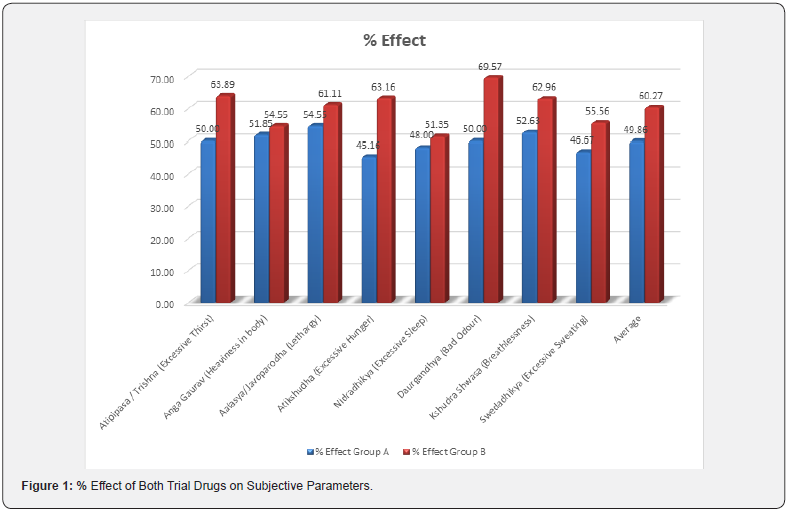
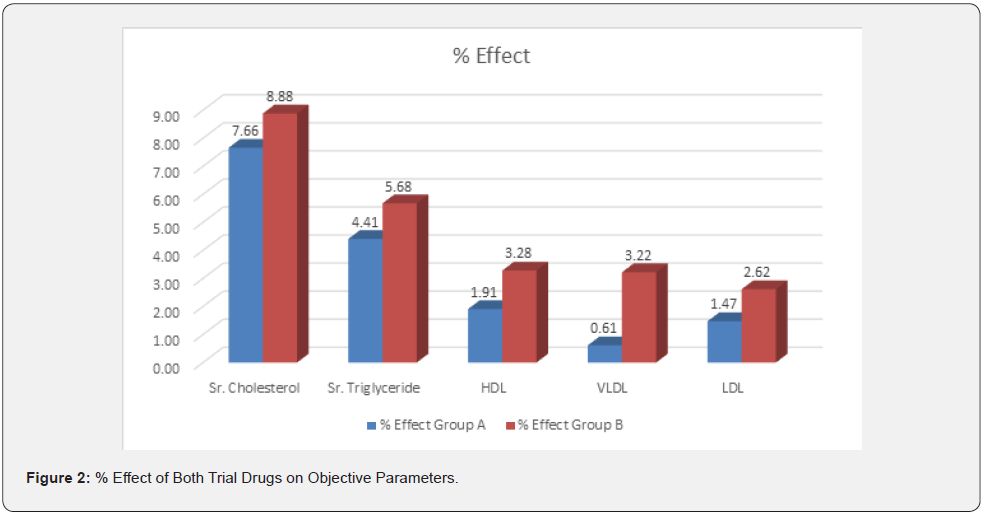
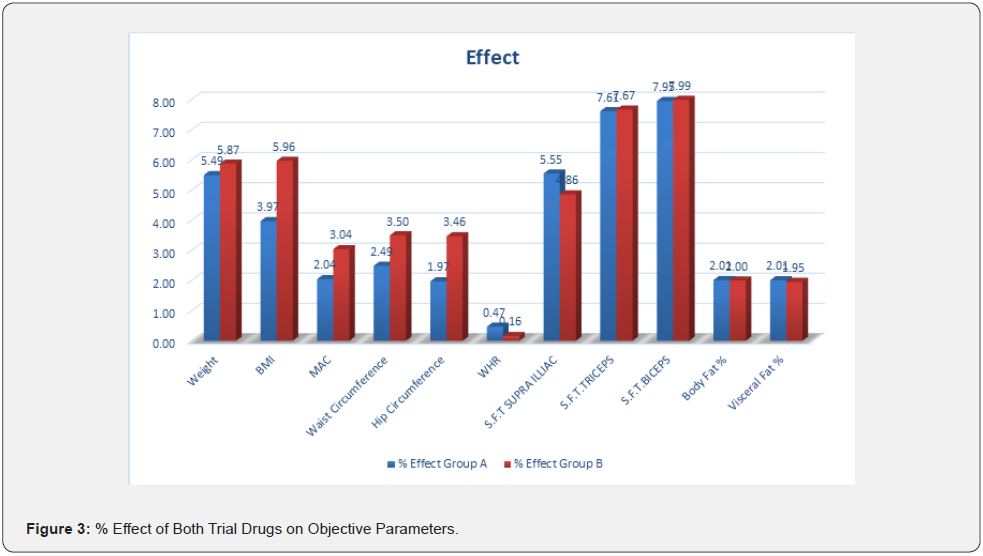
Conclusion
From above study this was concluded that etiological factors i.e., Dietary, Psychological & life style related mainly vitiate Kapha Meda which vitiated obstruct the path of Vata and causes its Avarana which results into provocation of Vata. Genetic factor, sedentary life style & Kapha predominant Prakriti were found to increases the prevalence of Obesity. Therefore, the line of treatment should be Kapha-Vata-Medo Hara & Apatarpanakara. Hence, A Clinical study was done to evaluate the efficacy on Navak Guggulu and Varadi Kashaya Vati in the management of Sthoulya w.s.r. to Childhood obesity. The outcome of this present study revealed that Navak Guggulu which was advocated in Group B showed better result overall in comparison to Varadi Kashaya Vati which was advocated in Group A. Navak Guggulu was found to have significant effect in reducing the symptoms of Medo Dushti and in reduction of objective parameters like weight, BMI, body circumferences and lipid profile.
References
- Shastri K, Chaturvedi G, Charka Samhita (2011) Vidhyotini Hindi Commentary. Chaukhamba Bharti Academy, Varanasi, Sutra Sthana, Santarpaniyam-Adhyaya 23/6p-436.
- Shastri K, Chaturvedi G, Charka Samhita (2011) Vidhyotini Hindi Commentary, Chaukhamba Bharti Academy, Varanasi, Sutra Sthana, Maharoga Adhyaya 20/17 pp. 405.
- Shastri A (2018) Sushruta Samhita, Ayurvedtatva Sandipika Hindi Commentary. Chaukhambha Sanskrit Sansthana, Varanasi, Sutrasthan 15/42 p.83.
- Sahoo K, Sahoo B, Choudhury AK, Sofi NY Kumar R, Bhadoria AJ (2015) Childhood obesity: Causes and consequences. J Family Med Prim Care 4(2): 187–192.
- Sahastra yogam Pratham prakran 63/10.
- Shastri L, Yogaratankara with Vidyotini Hindi Commentary edited by Bhisagratna Brahmasankar Sastri, Medoroga Chiktas Verse no -1, Chaukhambha Prakashan, Varanasi, p. 97.
- Shri Satya Narayan Shastri (Part 1) (2014) Charaka Samhita with elaborated Vidhyotini Hindi commentary Sutrasthan Langhan-bruhmniya Adhyaya; chapter 22 verse 24; Varanasi Chaukhambha Bharty academy, pp. 429.
- Vyas KY, Bedarkar P, Galib R, Prajapati PK (2017) Antihyperlipidemic activity of Navaka Guggulu prepared with fresh (Naveena) and old (Purana) Guggulu: A randomized clinical trial. Med J DY Patil Univ 10(3): 235-245.
- Bhatt AD, Dalal DG, Shah SJ, Joshi BA, Gajjar MN, et al. (1995) Conceptual and methodologic challenges of assessing the short-term efficacy of Guggulu in obesity: Data emergent from a naturalistic clinical trial. J Postgrad Med 41(1): 5-7.
- Sushruta, Sushruta Samhita, with the Commentaries, Nibandhasangraha of Dalhanacharya and Nyayachandrika of Sri Gayadasa, Edited by Yadavji Trikamji acharya Su.Su.15/16 (8th edn), Varanasi, Chaukhambha Orientalia, pp. 824.
- J U Chinchu, Mohind C Mohan, S J Rahitha Devi, B Prakash Kumar (2018) Evaluation of anti-inflammatory effect of Varanadi Kashayam (decoction) in THP-1-derived macrophages. Ayu 39(4): 243–249.






























